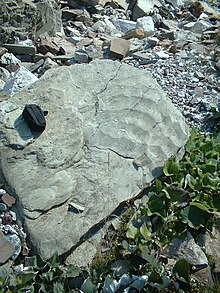Throwing formation

The Werfen Formation, or Werfener layers , is a lithostratigraphic formation of the lower Triassic (the Scythian ) of the eastern alpine nappes and in the southern alpine . It is the product of repeated flooding by the Tethys Sea .
history
The Werfen layers were first described by Karl Lill von Lilienbach in 1832. The formation is named after the market town of Werfen 40 kilometers south of the city of Salzburg .
Definition and distribution area
The Werfen formation begins in the Eastern Alpine area in the Tyrolean lowlands, for example in the Schwaz to Wörgl area towards the east over the Alpine Buntsandstein. The formation reaches a thickness of up to 300 meters, according to some authors it should be up to 500 meters thick. The Werfen Formation is underlain by the Alpine Haselgebirge Formation or lies discordantly above the Paleozoic of the Grauwackenzone. It is overlaid by the Reichenhall formation . Towards the west, it is interlocked with the alpine red sandstone formation , on which it is partially superposed. In the southern Alpine region, the Werfen formation is up to 400 meters thick, is underlain by the Bellerophon formation and overlaid by the Richthofen conglomerate and the Lower Sarl dolomite . The Werfen formation often appears on the flanks of the larger valleys and at the base of many mountain groups.
Subformations
Eastern Alps
Alexander Tollmann divides the formation, which he calls Werfener layers , into three areas: Werfener quartzites lying on the ground, which can be hundreds of meters thick , as in the area south of the Dachstein or in the Admonter shed zone. The central area, the Werfener Schiefer, which in many places can also be the only link in the formation, is made up of red, purple, green, gray slate, clay stones or schisty sandstones, which are yellowish or brownish weathered and formed in shallow sea areas. In the hanging wall, especially in the Kalkhochalpen, Werfener Kalke follow . This layer section is a maximum of 30 meters thick. In the Mesozoic of the Central Alps, the Scythian is represented by thin claystones, the Alpine red slate .

Southern Alps

In the southern alpine part of the Werfen formation, up to nine layers are differentiated, but these can be completely or partially missing due to erosion in the anisium . These are the tesero- oolite in the lying position , which consists of thin-banked calcoolites and is up to six meters thick. This is followed by 25 to 50 meters thick ostracod marl with limestone banks and Schill layers, the so-called Mazzin layers . On top of this follow brightly colored and evaporitic Andraz layers with a thickness of about 15 meters. The Seis layers are gray and yellowish-gray limestone, marl limestone or marl limestone. This layer element reaches thicknesses between 20 and 40 meters. Above this, a gastropod oolite follows , which can also occur between the Andraz and Seis layers. This oolithic layer can be up to 50 meters thick. The 40 to 80 meter thick Campill layers are mostly reddish in color and contain numerous sedimentary structures such as ripple marks, current marks or flow bulges. Dry cracks are evidence of temporary drying out. Above this are the Val Badia layers , these calcareous to marly sediments are up to 50 meters thick. The Cencenighe layers are partly silty, partly dolomites, dolomitic limestone and calcarenite. The partially evaporitic San Lucano layers are attributed by some authors to the Lower Sarl dolomite.
Fossil guide
The Werfener quartzite is considered to be fossil. The Werfener Schist and the Werfener Kalke carry fossils that allow a separation into the southern Alpine lower levels Seis and Campil. In the southern Alps, the Werfen formation is rich in various fossils.
Natural resources
Siderite , anchorite and barite occur in the Werfen layers . The sidereal ores used to be mined in places. There are also gypsum deposits, for example at Pfennigbach near Puchberg am Schneeberg , which is one of the largest eastern Alpine gypsum deposits.
Individual evidence
- ↑ Alexander Tollmann: Analysis of the classical North Alpine Mesozoic. Stratigraphy, fauna and facies of the Northern Limestone Alps . Part II of the monograph of the Northern Limestone Alps, Verlag Deuticke, Vienna 1976, ISBN 3-7005-4412-X , p. 57.
- ^ Erich Thenius: Lower Austria. Geology of the Austrian federal states in brief individual representations. 2nd expanded edition, Vienna 1974, p. 113f.
- ↑ Alexander Tollmann: Analysis of the classical North Alpine Mesozoic. Stratigraphy, fauna and facies of the Northern Limestone Alps . Part II of the monograph of the Northern Limestone Alps, Verlag Deuticke, Vienna 1976, ISBN 3-7005-4412-X , p. 57ff.
- ^ Otto F. Geyer: The southern Alps between Lake Garda and Friuli, collection of geological guides . Volume 86, Verlag Borntraeger, Berlin-Stuttgart 1993, ISBN 3-443-15060-8 , p. 89.
- ↑ Alfonso Bosellini: Geologia delle Dolomiti. Athesia, Bozen 1996, ISBN 88-7014-889-0 , p. 80.
- ↑ Alexander Tollmann: Analysis of the classical North Alpine Mesozoic. Stratigraphy, fauna and facies of the Northern Limestone Alps . Part II of the monograph of the Northern Limestone Alps, Verlag Deuticke, Vienna 1976, ISBN 3-7005-4412-X , p. 58ff.
- ^ Otto F. Geyer: The southern Alps between Lake Garda and Friuli, collection of geological guides . Volume 86, Verlag Borntraeger, Berlin-Stuttgart 1993, ISBN 3-443-15060-8 , p. 85ff.
- ↑ Alexander Tollmann: Analysis of the classical North Alpine Mesozoic. Stratigraphy, fauna and facies of the Northern Limestone Alps . Part II of the monograph of the Northern Limestone Alps, Verlag Deuticke, Vienna 1976, ISBN 3-7005-4412-X , p. 52ff.
- ↑ Alexander Tollmann: Analysis of the classical North Alpine Mesozoic. Stratigraphy, fauna and facies of the Northern Limestone Alps . Part II of the monograph of the Northern Limestone Alps, Verlag Deuticke, Vienna 1976, ISBN 3-7005-4412-X , p. 60.